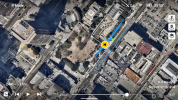More anecdotal observations:
Flew three flights in downtown LA. Clear skies. Busy area but I've flown there for years. When you know how it works, it can be done without incident. Home point can take a little longer but most of the buildings are below 5 floors so not too bad.
Cold start took 6 mins until first home point (12 SVs). The first 8 took under one minute but the last 4 took forever. I had a decent view of the sky. Even in the air, the total SV count never got above 15 the whole flight. Got a couple "weak gps" warnings as the SV count dipped to 12 and 13 a few times.
View attachment 144664
(You can see here, I had a pretty open view of the sky. I was at or about the height of the nearest buildings at this point.)
Oddly, the second flight (warm boot) took almost as long to get enough GNSS for the home point in pretty much the same conditions and very close to the first. Similar to the cold boot. Weird.
Third flight, even more open area but again lots around it. Took less time to get the home point but it was by no means fast. Maybe 3 minutes. Never had more than 18 SV.
The odd thing is no matter what the SV count was or the weak GPS warnings, the
M3C flew on rails. It was locked in. Super steady and easy to fly. This makes me wonder if the
M3C is being more picky about its SVs somehow to get the same or better result. A busy urban environment is going to have multipath and maybe even some RF in the GNSS bands. It could be it was ignoring some signals that were possibly echoing (multipath) or had low SNR.
Regardless, it takes a few minutes longer than my Inspires or
A3 based craft and might have lower numbers but the
M3C flies so well, so I am not that bothered.
I need to see what happens when I put it into a challenging environment where there is lots of multipath and limited view of the sky (skyscrapers). The Inspire will predictably lose its fix and drop to ATTI several times in these environments. I wonder how the
M3C will handle it.













